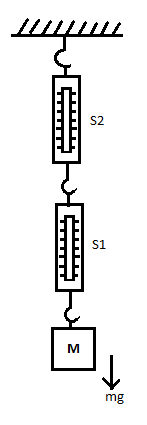
A light spring balance hangs from the hook of the other light spring balance and a block of mass M kg hangs from the former one. Then, the true statement about the scale reading is
$ (A) $ Both the scales read $ M\text{ }kg $ each
$ \left( B \right) $ The scale of the lower one reads $ M\text{ }kg $ and of the upper one zero.
$ \left( C \right) $ The reading of the two scales can be anything but the sum of the readings will be $ M\text{ }kg $ .
$ \left( D \right) $ Both the scales read $ M/2\text{ }kg $ .
Answer
514.2k+ views
Hint: Here we are given the data that two spring balances are hanging together provided that another mass block is hanging below the two spring balances. Let the upper spring balance be called $ S2 $ and lower spring balance be called $ S1 $ . We are also told that both the spring balances are light that means they are massless. So in order to solve this question we will use a simple concept of force that is net force acting on a system should be zero.
Complete step by step answer:
See the diagram for reference:

Now here the force acting on the mass block $ M $ is mg (its weight) in a downward direction. As both of the spring balances are massless then the reading of the lower spring balance will be $ S1 $ (due to mass block) and the reading of upper spring balance will be $ S2 $ (due to $ S1 $ and mass block). But spring balances are massless so the reading of both of the springs should be the same , that is M. Here, whatever force is experienced by $ S1 $ the same amount of force is experienced by $ S2 $ because the net force on the system should be zero. Therefore, $ S1=S2 $ . So when forces on both of the spring balances are equal then the reading will also be equal ( $ M\text{ }kg $ ).
Hence, option $ \left( A \right) $ is the correct option among all the given four options.
Note:
One has to note that if both of the spring balances were not massless and had some mass then reading on both of the spring balances would have been different, that is $ S1
Complete step by step answer:
See the diagram for reference:

Now here the force acting on the mass block $ M $ is mg (its weight) in a downward direction. As both of the spring balances are massless then the reading of the lower spring balance will be $ S1 $ (due to mass block) and the reading of upper spring balance will be $ S2 $ (due to $ S1 $ and mass block). But spring balances are massless so the reading of both of the springs should be the same , that is M. Here, whatever force is experienced by $ S1 $ the same amount of force is experienced by $ S2 $ because the net force on the system should be zero. Therefore, $ S1=S2 $ . So when forces on both of the spring balances are equal then the reading will also be equal ( $ M\text{ }kg $ ).
Hence, option $ \left( A \right) $ is the correct option among all the given four options.
Note:
One has to note that if both of the spring balances were not massless and had some mass then reading on both of the spring balances would have been different, that is $ S1
Recently Updated Pages
Master Class 11 Economics: Engaging Questions & Answers for Success

Master Class 11 English: Engaging Questions & Answers for Success

Master Class 11 Social Science: Engaging Questions & Answers for Success

Master Class 11 Biology: Engaging Questions & Answers for Success

Class 11 Question and Answer - Your Ultimate Solutions Guide

Master Class 11 Business Studies: Engaging Questions & Answers for Success

Trending doubts
10 examples of friction in our daily life

One Metric ton is equal to kg A 10000 B 1000 C 100 class 11 physics CBSE

Difference Between Prokaryotic Cells and Eukaryotic Cells

1 Quintal is equal to a 110 kg b 10 kg c 100kg d 1000 class 11 physics CBSE

State the laws of reflection of light

Explain zero factorial class 11 maths CBSE




